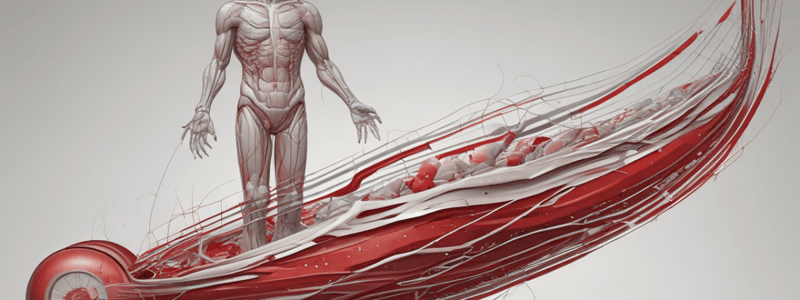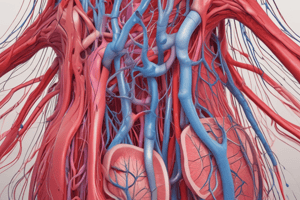Podcast
Questions and Answers
What is the blood volume in milliliters for a human weighing 70 kg?
What is the blood volume in milliliters for a human weighing 70 kg?
- 700 ml
- 100 ml
- 5000 ml (correct)
- 750 ml
If a person weighs 80 kg, what would be the approximate blood volume in milliliters?
If a person weighs 80 kg, what would be the approximate blood volume in milliliters?
- 6500 ml
- 9000 ml
- 5500 ml
- 8000 ml (correct)
What is the blood volume in microliters for a person with a body weight of 60 kg?
What is the blood volume in microliters for a person with a body weight of 60 kg?
- 55000 µL
- 50000 µL
- 60000 µL (correct)
- 45000 µL
If a person has a blood volume of 6000 ml, what would be their approximate weight in kilograms?
If a person has a blood volume of 6000 ml, what would be their approximate weight in kilograms?
What is the approximate blood volume in milliliters for a person weighing 90 kg?
What is the approximate blood volume in milliliters for a person weighing 90 kg?
What is the highest number among the numbers discussed in the previous figure?
What is the highest number among the numbers discussed in the previous figure?
Which number is the lowest among the numbers mentioned in the previous figure?
Which number is the lowest among the numbers mentioned in the previous figure?
Why does gaseous exchange take place at a more leisurely pace when relative blood flow is low?
Why does gaseous exchange take place at a more leisurely pace when relative blood flow is low?
What effect does low relative blood flow have on the efficiency of gaseous exchange?
What effect does low relative blood flow have on the efficiency of gaseous exchange?
What is the sum of all the numbers discussed in the previous figure?
What is the sum of all the numbers discussed in the previous figure?
Which number was not discussed in the previous figure?
Which number was not discussed in the previous figure?
How does high relative blood flow impact gaseous exchange in the lungs?
How does high relative blood flow impact gaseous exchange in the lungs?
If a new number were to be added that is greater than 100 but less than 150, what could it be?
If a new number were to be added that is greater than 100 but less than 150, what could it be?
What happens when gaseous exchange occurs at a leisurely pace in the lungs?
What happens when gaseous exchange occurs at a leisurely pace in the lungs?
In what scenario would gaseous exchange be impeded in the lungs?
In what scenario would gaseous exchange be impeded in the lungs?
What happens when a person breathes pure O2 and the PO2 in the blood becomes 650 mmHg?
What happens when a person breathes pure O2 and the PO2 in the blood becomes 650 mmHg?
What are the potential consequences of oxygen becoming free radicals in the body?
What are the potential consequences of oxygen becoming free radicals in the body?
How does an increased PO2 level in the blood affect oxygen molecules?
How does an increased PO2 level in the blood affect oxygen molecules?
What is the main concern associated with oxygen transforming into free radicals?
What is the main concern associated with oxygen transforming into free radicals?
Why does exposure to pure O2 at high pressures pose a risk to biological systems?
Why does exposure to pure O2 at high pressures pose a risk to biological systems?
What is the oxygen content of 15g of Hb when Po2 = 40?
What is the oxygen content of 15g of Hb when Po2 = 40?
At what Po2 level does Hb become 75% saturated?
At what Po2 level does Hb become 75% saturated?
What represents the transition point from zone 3 to zone 2?
What represents the transition point from zone 3 to zone 2?
Which part of the brain contains cardiac, vascular, and respiratory centers?
Which part of the brain contains cardiac, vascular, and respiratory centers?
What happens when the respiratory center in the medulla oblongata sends impulses?
What happens when the respiratory center in the medulla oblongata sends impulses?
What effect does an increase in temperature and binding to 2-3 DPG have on oxygen?
What effect does an increase in temperature and binding to 2-3 DPG have on oxygen?
How does binding to 2-3 DPG affect the oxygen-hemoglobin dissociation curve?
How does binding to 2-3 DPG affect the oxygen-hemoglobin dissociation curve?
What is the role of 2-3 DPG in relation to hemoglobin?
What is the role of 2-3 DPG in relation to hemoglobin?
How does an increase in temperature affect hemoglobin's affinity for oxygen?
How does an increase in temperature affect hemoglobin's affinity for oxygen?
What is the consequence of reduced oxygen binding to hemoglobin?
What is the consequence of reduced oxygen binding to hemoglobin?
How does the release of oxygen by hemoglobin change in response to an increase in 2-3 DPG levels?
How does the release of oxygen by hemoglobin change in response to an increase in 2-3 DPG levels?
What is the primary reason for oxygen being released from hemoglobin at the tissues?
What is the primary reason for oxygen being released from hemoglobin at the tissues?
At what oxygen saturation level is hemoglobin 25% saturated?
At what oxygen saturation level is hemoglobin 25% saturated?
What is the oxygen saturation level when hemoglobin binds to 4 (O2) molecules?
What is the oxygen saturation level when hemoglobin binds to 4 (O2) molecules?
When hemoglobin binds to 2 (O2) molecules, what percentage saturated is it?
When hemoglobin binds to 2 (O2) molecules, what percentage saturated is it?
At what saturation level is hemoglobin not bound to any oxygen molecules?
At what saturation level is hemoglobin not bound to any oxygen molecules?
What happens to the iron in hemoglobin when it binds to oxygen?
What happens to the iron in hemoglobin when it binds to oxygen?
What effect does Co2 binding to hemoglobin have on oxygen release?
What effect does Co2 binding to hemoglobin have on oxygen release?
At what pressure does the respiratory center depend for oxygen regulation?
At what pressure does the respiratory center depend for oxygen regulation?
What happens to hemoglobin when it transitions from the R state to the T state?
What happens to hemoglobin when it transitions from the R state to the T state?
What effect does the Bohr's effect have on oxygen binding?
What effect does the Bohr's effect have on oxygen binding?
What is the significance of Hbs being 50% saturated at a Po2 of 26?
What is the significance of Hbs being 50% saturated at a Po2 of 26?
Why is a high apical PO2 unable to correct low PO2 in the left ventricle or left atrium?
Why is a high apical PO2 unable to correct low PO2 in the left ventricle or left atrium?
What happens when high apical PO2 mixes with low PO2 in the heart?
What happens when high apical PO2 mixes with low PO2 in the heart?
How does the inability of high apical PO2 to correct low PO2 impact oxygen delivery to the tissues?
How does the inability of high apical PO2 to correct low PO2 impact oxygen delivery to the tissues?
What effect does mixing high apical PO2 with low PO2 have on oxygen distribution in the body?
What effect does mixing high apical PO2 with low PO2 have on oxygen distribution in the body?
How does the mixing of varying oxygen levels in the heart chambers affect tissue oxygenation?
How does the mixing of varying oxygen levels in the heart chambers affect tissue oxygenation?
What is the significance of the curve in the first figure being shifted to the right?
What is the significance of the curve in the first figure being shifted to the right?
Why is it logically expected for saturation to be higher in the first figure at a Po2 of 40?
Why is it logically expected for saturation to be higher in the first figure at a Po2 of 40?
What effect does an increase in 2-3 DPG levels have on the oxygen-hemoglobin dissociation curve?
What effect does an increase in 2-3 DPG levels have on the oxygen-hemoglobin dissociation curve?
How might a decrease in pH in exercising cells affect the oxygen-hemoglobin dissociation curve?
How might a decrease in pH in exercising cells affect the oxygen-hemoglobin dissociation curve?
Which factor does NOT contribute to a right shift in the oxygen-hemoglobin dissociation curve?
Which factor does NOT contribute to a right shift in the oxygen-hemoglobin dissociation curve?
What gets released by the bone marrow when a baby takes his first breath?
What gets released by the bone marrow when a baby takes his first breath?
What initiates the release of (2α 2β) according to the text?
What initiates the release of (2α 2β) according to the text?
What is the role of (2α 2β) released by the bone marrow?
What is the role of (2α 2β) released by the bone marrow?
Which element is not released by the bone marrow when a baby takes his first breath?
Which element is not released by the bone marrow when a baby takes his first breath?
What happens to the bone marrow when (2α 2β) is released as a baby takes his first breath?
What happens to the bone marrow when (2α 2β) is released as a baby takes his first breath?
Flashcards are hidden until you start studying




